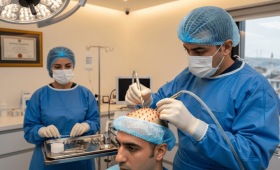What Is FUE Hair Transplant?
FUE (Follicular Unit Extraction) is a modern hair transplant technique based on the principle of harvesting hair follicles one by one from the donor area (usually the back of the head) using a micromotor or manual tools and placing them into micro-channels in the recipient area. Since this method does not require a surgical incision or stitches, it does not leave a noticeable scar in the donor area. The healing process is much faster and more comfortable. It is an ideal option especially for hair transplantation in small areas, or for delicate procedures like beard or eyebrow transplants.
What Is FUT Hair Transplant?
FUT (Follicular Unit Transplantation) is a traditional hair transplant method where a strip of hair-bearing skin is removed from the donor area. This strip is then divided into small grafts (groups of hair follicles) under a microscope. These grafts are placed into channels opened in the bald area. The FUT method can be preferred for patients with advanced hair loss as it allows for a large number of grafts to be harvested in a single session. However, it is a surgical procedure that requires stitches and leaves a permanent scar in the donor area.
Which Method Is More Common Today?
Today, the FUE method is much more commonly used in hair transplant operations than FUT. The most important reason for this is that FUE is less invasive, does not leave a permanent scar in the donor area, and has a faster healing process. Patients who prioritize aesthetic results and minimal discomfort often prefer FUE. The FUT method, however, can still be used in special cases where a very large area needs to be covered and a high number of grafts is required.
Which Method Has a Faster Healing Process?
The FUE method offers a much faster healing process thanks to the individual micro-incisions made in the donor area. These micro-incisions scab over in a few days and generally heal completely within one to two weeks. During this process, the patient can return to their daily life earlier. In the FUT method, because a strip of skin is removed and stitches are used, the healing process can be longer and more painful. The removal of the stitches also brings an additional process.
Which Method Leaves a Noticeable Scar?
The FUT (Follicular Unit Transplantation) method leaves a permanent and linear stitch scar due to the strip taken from the donor area. This scar can be clearly visible when the hair is cut short, which is the most significant aesthetic disadvantage for patients. In the FUE method, since hair follicles are harvested one by one, only punctate scars form. These punctate scars are very small and become almost completely invisible by the end of the healing process. This makes FUE ideal for those concerned about scarring.
Which Method Is More Suitable for Short Hair?
The FUE method is much more suitable for patients who like to wear their hair short or plan to cut their hair short in the future. The punctate scars formed in FUE are so small that they are almost unnoticeable even when the hair is cut very short. In FUT, the strip-shaped scar can be easily noticed when the hair is short. Therefore, patients concerned about the appearance of a scar in the donor area can comfortably choose FUE.
Which Method Is More Suitable for Long Hair?
The FUT method may be more suitable for patients who prefer to wear their hair long and do not want their hair transplant operation to be noticeable. In FUT, the hair over the stitched area naturally covers the scar after the strip is removed. This way, the scar from the operation is not visible from the outside as long as the hair is not shortened. However, this is only a viable option for patients who wear their hair long and do not plan to change their haircut.

Which Method Allows for a Higher Number of Grafts?
The FUT method allows for a higher number of grafts to be harvested in a single session. Generally, 4000 to 5000 grafts or more can be taken in a single operation. This is a great advantage for patients with advanced hair loss. The FUE method is more time-consuming, and the number of grafts that can be harvested in a single session is generally limited to around 4000. Therefore, if a very large area needs to be transplanted, FUT can provide faster results.
Which Method Has a Higher Graft Survival Rate?
Both methods can have a high graft survival rate, but this depends more on the surgeon’s experience and the techniques used. In FUE, the risk of damage to the follicles is lower because the grafts are harvested one by one. In FUT, the grafts are more protected because a strip of tissue is removed. However, in the hands of a good surgeon, a graft survival rate of over 90% can be achieved with both methods. The time the grafts spend outside the body is another factor that affects the survival rate.
Is FUE or FUT More Painful?
The FUT method can cause more pain after the operation. Due to the removal of a strip of the scalp and the use of stitches, significant pain or sensitivity can be felt after the operation. This pain is usually controlled with pain relievers. The FUE method, being minimally invasive, has a lower level of post-operative pain and it usually disappears within a few days. This makes FUE a more comfortable option.
Is FUE or FUT More Costly?
Generally, the FUE method is more costly than FUT. This is because FUE is a longer process that requires more technical equipment (micromotors, etc.). The harvesting and implantation of each hair follicle one by one increases the labor cost of the operation. The FUT method can be completed in a shorter time and requires less technological equipment, which makes its price more affordable. However, the price difference varies depending on the clinic’s location and the quality of service.
How Is the Donor Area Prepared for FUE and FUT?
For the FUE method, the donor area (usually the back of the head) is completely shaved. This allows the hair follicles to be harvested more easily and healthily. For the FUT method, it is not necessary to shave the entire head; only the area where the strip of scalp will be removed is shaved. After this strip is removed, the hair over the stitched area can be grown out to cover the scar. For both methods, the donor area is numbed with a local anesthetic.
How Is the Implantation Area Prepared for FUE and FUT?
In both the FUE and FUT methods, micro-channels are opened in the bald area where the hair follicles will be placed. The angle, direction, and depth of these channels are the most important factors that determine the success of the operation and the natural look of the hair. The channels should be opened in a way that is consistent with the natural direction of hair growth. In both methods, the grafts are carefully placed into these pre-opened channels.
Which Method Is More Suitable for a Denser Hairline?
The FUE method offers more flexibility to create a denser and more compact hairline. Since the grafts are harvested and implanted one by one, surgeons can implant them more closely among existing hairs or in the hairline area. The FUT method can also create a natural-looking hairline, but it may be more difficult to achieve the level of precision and density that FUE provides.
Which Method Is Better for a Large Bald Area?
If the patient has a very large bald area that needs to be covered in a single session, the FUT method may be more advantageous. FUT allows for a higher number of grafts to be transferred in a single operation. This results in a more comprehensive outcome with fewer sessions. The FUE method can also be used for large areas, but in this case, the operation time may be longer or multiple sessions may be required.
Can FUE and FUT Be Combined?
Yes, FUE and FUT methods can be combined in a single operation. This is a technique applied especially to patients who have a limited donor area but need a very large number of grafts. First, a large strip of grafts is removed with FUT, and then the remaining grafts are harvested with the FUE method. This complex operation maximizes the potential of the donor area, allowing the patient to reach the highest possible number of grafts.
What Are the Main Advantages of FUE?
The main advantages of FUE include not leaving a visible scar, less pain, and a faster healing process. Additionally, since the hair follicles are harvested one by one, it is possible for the hair transplant operation to yield more natural results. The FUE method is ideal for patients who prefer to wear their hair short. Patient comfort is also higher because it is a minimally invasive method.
What Are the Main Disadvantages of FUE?
The main disadvantages of FUE are that the operation time is longer and it is generally more costly than FUT. The number of grafts that can be harvested in a single session is also less than in FUT, which may require additional sessions for patients with a large bald area. Additionally, there may be a risk of thinning in the donor area if too many hair follicles are harvested.
What Are the Main Advantages of FUT?
The most important advantage of FUT is that it allows for the transfer of the highest number of grafts in a single session. This saves time for patients with advanced hair loss. The operation time can be shorter compared to FUE. Additionally, since the grafts are harvested in a strip, they are less delicate, and high survival rates can be achieved in the hands of an experienced surgeon.
What Are the Main Disadvantages of FUT?
The most obvious disadvantage of FUT is that it leaves a permanent and linear scar in the donor area. This can be a serious aesthetic problem for patients who wear their hair short or plan to in the future. The healing process can be more painful and longer than FUE. Also, since it is a surgical procedure, it carries potential complications such as the risk of infection and bleeding.
Which Method Requires Shaving the Hair?
The FUE method requires shaving the donor area and usually the entire head. This allows the surgeon to easily see and harvest the hair follicles. The FUT method does not require the entire head to be shaved; only the area where the strip of scalp will be removed is shaved. This is a significant advantage for patients who wear their hair long.
Which Method Is More Suitable for a Second Transplant?
When a second hair transplant is needed, the FUE method is generally a more suitable option. FUE offers the possibility of harvesting grafts from areas that were not damaged in the first operation and preserves the potential of the donor area. Especially if FUT was performed in the first operation, it may be possible to hide the FUT scar and perform a new hair transplant with FUE. This makes FUE a versatile option.
Can Body Hair Be Used in FUE and FUT?
With the FUE method, if the donor area is insufficient, hair follicles can be harvested from other parts of the body such as the beard, chest, or back. Although these follicles may not be as thick and durable as the hair follicles from the back of the head, they can be used to increase hair density. In the FUT method, since hair follicles are only harvested from the scalp, there is no possibility of using body hair.
Which Method Provides More Natural-Looking Results?
Natural-looking results are more related to the surgeon’s experience and artistic ability rather than the method used. However, FUE has the potential to yield a more natural result because the grafts are harvested one by one and the direction of implantation can be determined more precisely. An expert surgeon can achieve successful results with both FUE and FUT by performing a transplant that is consistent with the patient’s hairline and the natural direction of hair growth.
What Is the Post-Operative Care for Each Method?
Post-operative care is similar for both methods; however, in FUT, special attention should be paid to the stitch line. In the first few days, it is important to avoid getting water on the donor and recipient areas, avoid strenuous activities, and be careful about the sleeping position. In FUE, because healing is faster, daily life can be resumed earlier. In FUT, it may take longer for the stitches to be removed and for the healing process to be completed.
How Long Does the Procedure Take for Each Method?
The duration of the FUE and FUT methods varies depending on the number of grafts to be implanted. The FUE method generally takes longer because each hair follicle is harvested and implanted one by one. An FUE operation of approximately 4000 grafts can take 8 to 10 hours. The FUT method can be completed more quickly because the strip is removed. However, separating the grafts under a microscope requires additional time.
Who Is a Better Candidate for FUE?
A good candidate for FUE is a person with a moderate level of hair loss, a sufficiently dense donor area, and someone who plans to wear their hair short. Additionally, those who do not want the linear scar from the FUT method, are looking for a less painful healing process, or are considering using body hair are also suitable candidates for FUE.
Who Is a Better Candidate for FUT?
A good candidate for FUT is a person with an advanced level of hair loss who wants to implant the maximum number of grafts possible in a single session. Additionally, patients with a limited donor area but who use their hair long and can thus hide the FUT scar may also be suitable for this method. FUT can be preferred by patients who want fast results and are not concerned about the scar.

Does Age Affect the Choice of Method?
Age does not directly affect the choice of method, but the hereditary pattern and level of hair loss are important. For example, a patient considering a hair transplant in their 20s may want to start with a method that damages the donor area less, like FUE, since they may experience more hair loss in later years. Instead of age, the quality of the donor area and the possibility of future hair loss are more determining factors.
Is a Doctor’s Experience Important for Both Methods?
Yes, a doctor’s experience is of critical importance for both methods. An experienced surgeon prevents damage to the hair follicles during harvesting and implantation and ensures a natural-looking result. In FUE, harvesting at the correct angle, and in FUT, removing the strip in a way that minimizes the scar, requires experience.
How Does Hair Type Affect the Choice of Method?
Hair type can significantly affect the choice of method. Curly and wavy hair may be difficult to harvest with the FUE method, so it requires a more experienced surgeon. Thick hair is ideal for both FUE and FUT as it increases the number of hair strands per graft. In thin hair, more grafts may be needed to create a sense of density.
What Are the Risks Associated with FUE?
The risks associated with FUE are generally minimal. Possible risks include infection, bleeding, thinning due to excessive harvesting in the donor area, and an unnatural look resulting from incorrect graft placement. However, these risks are minimized in an operation performed by an experienced surgeon and in hygienic conditions.
What Are the Risks Associated with FUT?
The most important risks associated with FUT are the permanent scar and the long-lasting pain and numbness after the operation. Additionally, since it is a surgical procedure, the risk of infection and bleeding is higher than with FUE. The healing process of the stitch line may be prolonged, and some patients may be at risk of developing keloid scars.
Can FUE Hide a Previous FUT Scar?
Yes, the FUE method can be used to hide the scar left by a previous FUT operation. The surgeon can camouflage the scar by implanting FUE-harvested hair follicles into and around the scar. This provides an effective solution for patients who want to wear their hair short and are bothered by the FUT scar. This procedure generally reduces the scar’s prominence significantly, although it may not make it completely invisible.
What Should I Ask My Doctor Before Deciding?
Before deciding, you should ask your doctor the following questions:
- Which method do you recommend and why?
- Is my donor area suitable for both methods?
- What are the possible risks and complications?
- How many grafts need to be transplanted, and which method is more suitable for this number?
- What is the total cost of the operation, and what is included in this price?
- Can I see before and after photos of your previous patients? These questions will help you make the right decision.



